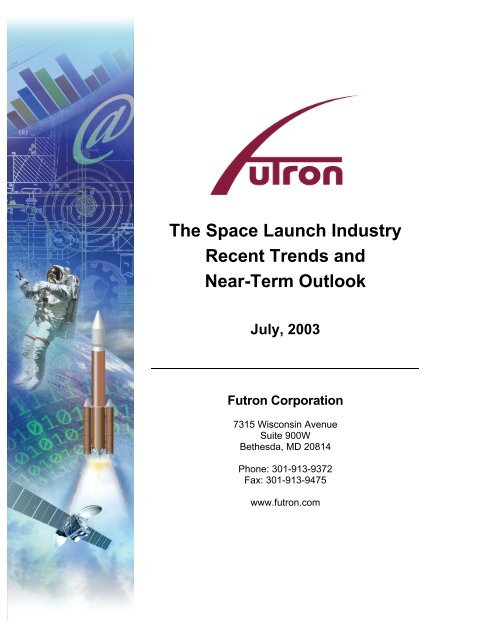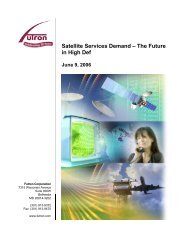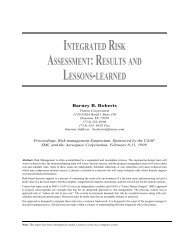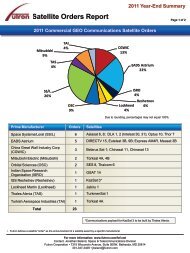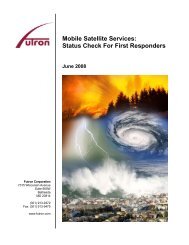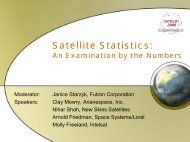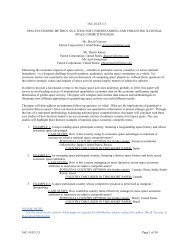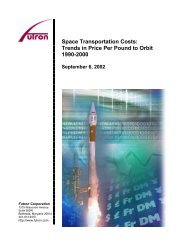1.0Executive Summary - Futron Corporation
1.0Executive Summary - Futron Corporation
1.0Executive Summary - Futron Corporation
You also want an ePaper? Increase the reach of your titles
YUMPU automatically turns print PDFs into web optimized ePapers that Google loves.
The Space Launch Industry<br />
Recent Trends and<br />
Near-Term Outlook<br />
July, 2003<br />
<strong>Futron</strong> <strong>Corporation</strong><br />
7315 Wisconsin Avenue<br />
Suite 900W<br />
Bethesda, MD 20814<br />
Phone: 301-913-9372<br />
Fax: 301-913-9475<br />
www.futron.com
1.0 Executive <strong>Summary</strong><br />
Since 1996, <strong>Futron</strong> has maintained an extensive database of past and future launch<br />
activity. <strong>Futron</strong> reviews over 20 space-related publications and over 30 on-line spacerelated<br />
resources to collect launch information. The database is updated on a daily<br />
basis.<br />
Using this information as a starting point, <strong>Futron</strong> analysts regularly review planned and<br />
proposed launch activity and generate launch forecasts. This type of forecast, referred<br />
to as a “supply-side” forecast, can be fairly accurate in predicting near-term launch<br />
activity.<br />
With the start of the third quarter of 2003, <strong>Futron</strong> has performed a rigorous analysis of<br />
future launch activity and generated a “best estimate” forecast for the next 18 months.<br />
In comparing projected 2003 and 2004 launch numbers with those from previous years,<br />
trends and significant points become apparent. Among those are:<br />
Worldwide launch activity (commercial and non-commercial) is cyclical, increasing<br />
some years and decreasing in others. However, by 2004, the launch industry will<br />
have experienced three years of consistent increases.<br />
2001 experienced the lowest number of commercial launches (16) since 1994. 2002<br />
saw a modest recovery (24) and the number of commercial launches will remain<br />
stable in 2003 and 2004 (23 and 26 respectively).<br />
While it is too early to say definitively, there is a preliminary trend towards increasing<br />
numbers of non-commercial launches.<br />
Regarding the number of GEO commercial satellites, 2000 and 2001 experienced a<br />
whiplash of a high of 30 followed by a low of 13. Since then, the number of GEO<br />
comsats has settled into the 20-23 range, which is consistent with the number of<br />
launched throughout the late 1990s.<br />
The three major commercial space-faring nations (USA, Russia, and Europe) have<br />
been battling mightily to distinguish themselves and garner launch orders. However,<br />
currently, the global launch-buying community seems equally satisfied with each<br />
nation’s products, as each nation will capture about 30% market share in 2003 and<br />
2004.<br />
There are ominous signs ahead for the commercial launch industry. While the nearterm<br />
commercial manifest if fairly stable, the outlook is much less robust after 2004.<br />
Two years ago in a White Paper like this one, <strong>Futron</strong> predicted there would be 19<br />
commercial launches in 2001 and 23 in 2002. The actual numbers were 16 and 24.<br />
2
2.0 Forecast Methodology<br />
The first step in developing <strong>Futron</strong>’s supply-side forecast starts with <strong>Futron</strong>’s Electronic<br />
Library of Space Activity (ELSA). ELSA is an extensive satellite and launch database<br />
that contains over 500,000 pieces of information including over 8,000 distinct launch<br />
events. All historical launches are contained in ELSA as well as proposed systems that<br />
have been announced in the public domain. Source data is gathered from over fifty<br />
open-source periodicals, websites, and technical documents and entered daily by<br />
<strong>Futron</strong> Analysts. The information in ELSA forms the basis for many of <strong>Futron</strong>’s<br />
consulting projects; however, we do sell the database, or parts of it, to select customers.<br />
<strong>Futron</strong> generates an initial list of planned launches from the information in ELSA. The<br />
next step is to apply analytic judgments regarding the likelihood of the planned<br />
launches. Many announced launches have no realistic chance of being launched as<br />
proposed. The satellites linked to these launches are referred to as “paper satellites”<br />
and they appear on the initial list because some organization made a public<br />
announcement of its intention to launch a satellite. However, these announcements are<br />
sometimes made for public relations or national pride reasons.<br />
<strong>Futron</strong> applies the following types of considerations to the initial list of announced<br />
launches to determine their likelihood of actually launching:<br />
‣ Satellite manufacturing contract status<br />
‣ Launch vehicle contract status<br />
‣ Market situation<br />
‣ Spectrum allocation approval status<br />
‣ Orbital slot approval status<br />
‣ Other regulatory issues such as export control<br />
‣ Track record of the satellite owner/operator<br />
‣ Technical risk<br />
What remains is a list of projected launches that theoretically could be launched during<br />
the time period, or “peak load.” However, several factors can affect the execution of a<br />
scheduled launch. These include:<br />
‣ Launch failures<br />
‣ Launch site scheduling conflicts<br />
‣ Technical problems with the launch vehicle<br />
‣ Satellite manufacturing problems<br />
‣ Regulatory issues<br />
‣ Business and financial issues<br />
Based on a historical analysis of projected versus actual launch activity, <strong>Futron</strong> has<br />
determined that the above issues tend to reduce the peak load forecast by<br />
approximately 25%.<br />
3
Another factor that must be considered is that some nations do not announce satellite<br />
launches in advance, usually for national security reasons. This is particularly true in<br />
Russia and China. With an in-depth understanding of historical launch activity and<br />
government policy statements, and a general knowledge of launch activity for various<br />
nations, the issue of unannounced future launch activity can be addressed.<br />
Once all these factors have been rigorously analyzed, considered and acted upon, the<br />
“best estimate” of future launch activity is produced.<br />
3.0 Forecast Results and Definitions<br />
Tables 1-4 show the number of commercial launches, non-commercial launches, total<br />
launches, and commercial satellites for the period 1998 through 2004. These tables<br />
show actual launch numbers for 1998 through June 2003 and projected launch numbers<br />
from July 2003 through 2004.<br />
Table 1: Commercial Launches by Country, 1998 – 2004<br />
Country 1998 1999 2000 2001 2002<br />
2003<br />
(Best Estimate)<br />
2004<br />
(Best Estimate)<br />
USA 22 15 7 3 5 7 6<br />
Russia 5 13 13 3 8 7 9<br />
Europe 9 8 12 8 10 6 7<br />
China 4 1 0 0 0 0 0<br />
Multinational 0 2 3 2 1 3 3<br />
Japan 0 0 0 0 0 0 1<br />
India 0 0 0 0 0 0 0<br />
Brazil 0 0 0 0 0 0 0<br />
Israel 0 0 0 0 0 0 0<br />
TOTAL 40 39 35 16 24 23 26<br />
Note: Ukraine had one commercial launch in 1998.<br />
Table 2: Non-Commercial Launches by Country, 1998 – 2004<br />
2003<br />
2004<br />
Country 1998 1999 2000 2001 2002<br />
(Best Estimate) (Best Estimate)<br />
USA 14 16 21 19 12 23 26<br />
Russia 19 15 23 20 17 15 12<br />
Europe 2 2 0 0 2 0 4<br />
China 2 3 5 1 5 5 5<br />
Multinational 0 0 0 0 0 0 0<br />
Japan 2 1 1 1 3 3 5<br />
India 0 1 0 2 1 2 3<br />
Brazil 0 1 0 0 0 1 1<br />
Israel 1 0 0 0 1 0 0<br />
TOTAL 40 39 50 43 41 49 56<br />
Note: North Korea had one non-commercial launch (attempt) in 1998.<br />
4
Table 3: Total Launches by Country, 1998 – 2004<br />
Country 1998 1999 2000 2001 2002<br />
2003<br />
(Best Estimate)<br />
2004<br />
(Best Estimate)<br />
USA 36 31 28 22 17 31 32<br />
Russia 24 28 36 25 25 22 21<br />
Europe 11 10 12 8 12 8 11<br />
China 6 4 5 1 5 5 5<br />
Multinational 0 2 3 2 1 3 3<br />
Japan 2 1 1 1 3 4 6<br />
India 0 1 0 2 1 2 3<br />
Brazil 0 1 0 0 0 1 1<br />
Israel 1 0 0 0 1 0 0<br />
TOTAL 80 78 85 59 65 72 82<br />
Table 4: Total Commercial Satellites by Orbit, 1998 – 2004<br />
2003<br />
2004<br />
1998 1999 2000 2001 2002<br />
(Best Estimate) (Best Estimate)<br />
GEO 22 22 30 13 23 21 20<br />
NGSO 82 54 19 7 11 12 14<br />
TOTAL 104 76 49 20 34 39 34<br />
Definitions<br />
Commercial launches are defined as launches that are internationally competed (i.e., available in<br />
principle to competitors in the international launch services market), or launches that are licensed by the<br />
U.S. Office of the Associate Administrator for Commercial Space Transportation of the Federal Aviation<br />
Administration, or privately financed launches.<br />
Commercial satellites are defined as spacecraft that serve a commercial function or are operated by a<br />
commercial entity, without regard to how they are launched. Certain Russian and Chinese domestic<br />
communications satellites are commercial if a significant portion of the transponders is offered for lease<br />
through commercial operators.<br />
GEO satellites are spacecraft that operate in geosynchronous orbit – an orbit approximately 22,300 miles<br />
above the equator in which a spacecraft completes one orbit around the Earth every 24 hours.<br />
NGSO satellites are spacecraft in non-geosynchronous orbits (NGSO), such as low Earth orbit (LEO),<br />
medium Earth orbit (MEO), elliptical orbits, and deep space probes.<br />
Launches are attributed to the country in which the primary vehicle manufacturer is based, with the<br />
exception of launches by Sea Launch, which are designated as “Multinational.”<br />
5
4.0 Trends and Significant Points<br />
Many significant points become apparent from Tables 1-4.<br />
Worldwide launch activity (commercial and non-commercial) is cyclical, increasing<br />
some years and decreasing in others. However, by 2004, the launch industry will<br />
have experienced three years of consistent increases.<br />
In looking at the total number of launches worldwide (Figure 1), there is no pronounced<br />
trend during the entire period shown. Instead, there are year-to-year variations, with the<br />
total number of launches increasing in some years and decreasing in others. However,<br />
in the latter part of the time period, there is a consistent trend towards increasing<br />
numbers of launches. The average annual increase from 2001 to 2004 is 11.5%.<br />
Figure 1: Total Launches Worldwide, 1998 - 2004<br />
90<br />
80<br />
70<br />
60<br />
50<br />
40<br />
30<br />
20<br />
10<br />
0<br />
1998 1999 2000 2001 2002 2003<br />
(Best<br />
Est.)<br />
2004<br />
(Best<br />
Est.)<br />
While this growth is welcome news to the launch industry, it should be noted that 2001<br />
was the worst year in terms of total launches since 1961. In that year, which<br />
coincidentally included President Kennedy’s announcement regarding a U.S. mission to<br />
the moon, there were only 47 total launches.<br />
2001 experienced the lowest number of commercial launches (16) since 1994. 2002<br />
saw a modest recovery (24) and the number of commercial launches for 2003 and<br />
2004 will remain stable (23 and 26 respectively).<br />
6
The 16 commercial launches that occurred in 2001 was the lowest number since 1994,<br />
when there were 14. Since that time, the commercial industry rebounded with 24<br />
launches in 2002 and <strong>Futron</strong> predicts that the number of commercial launches will<br />
remain steady for the next two years.<br />
In the classic example of a glass half empty or half full, this steady rate of between 23<br />
and 26 launches can be viewed as either good or bad. On one hand, a commercial<br />
launch rate in the low 20s is well below the total launch capacity of the industry and it is<br />
also well below the number of launches experienced during the late 1990s when the<br />
LEO telecommunications satellite constellations were being launched (ORBCOMM,<br />
Iridium, and Globalstar). On the other hand, 23-26 launches a year is well above the<br />
number recorded in 2001 and it is also well above the average experienced prior to the<br />
LEO constellation debut. In the four years prior to the launching of the LEO<br />
constellations (1993-1996), the average annual commercial launch rate was 15.5.<br />
While it is too early to say definitively, there is a preliminary trend towards increasing<br />
numbers of non-commercial launches.<br />
<strong>Futron</strong> predicts the number of non-commercial launches will grow at a healthy rate in<br />
2003 and again in 2004 (19.5% and 14.3% respectively). While two years is not nearly<br />
enough time to indicate a strong trend, this is a pronounced increase and it is sustained<br />
over more than just one year.<br />
Regarding the number of GEO commercial satellites, 2000 and 2001 experienced a<br />
whiplash of a high of 30 followed by a low of 13. Since then, the number of GEO<br />
comsats has settled into the 20-23 range, which is consistent with the number<br />
launched throughout the late 1990s.<br />
The GEO commercial satellite market, traditionally viewed as a very attractive market by<br />
launch providers, has gone through a roller coaster ride with an extreme high followed<br />
immediately by an extreme low. <strong>Futron</strong> predicts that this market will settle down for the<br />
next couple years.<br />
Another trend emerging in the GEO comsat market is the moderation in the growth of<br />
the size of the average GEO comsat. As measured by the number of transponders, the<br />
average GEO comsat only grew by about 3% recently (see Figure 2).<br />
7
Figure 2: GEO Commercial Satellite Size<br />
Ave. Transponders per Satellite<br />
45<br />
40<br />
35<br />
30<br />
25<br />
20<br />
15<br />
10<br />
5<br />
0<br />
39.4 40.5<br />
30.5<br />
28.5<br />
26.3<br />
1994-1995 1996-1997 1998-1999 2000-2001 2002-2003<br />
Launch Year<br />
The three major commercial space-faring nations (USA, Russia, and Europe) have<br />
been battling mightily to distinguish themselves and garner launch orders. However,<br />
currently, the global launch-buying community seems equally satisfied with each<br />
nation’s products, as each nation will capture about 30% market share in 2003 and<br />
2004.<br />
Market share has long been a benchmark for launch providers (even though launch rate<br />
is a more direct measure of the health of a launch company). In recent years, launch<br />
providers have become increasingly aggressive in their sales and marketing activities.<br />
Part of the sales strategy for most launch providers is to highlight the attractive features<br />
of one’s own launch vehicle, such as reliability, schedule assurance, and customer<br />
service.<br />
Without a doubt, there are differences in these key characteristics among the various<br />
launch providers. However, no single launch provider or launch nation is currently<br />
dominating the market. Global launch buyers have more or less evenly divided up the<br />
market among USA, European, and Russian launchers (see Figure 3). It should be<br />
noted that many European launches involve dual-manifested Ariane 5 launches. Thus,<br />
Europe’s market share in terms of satellites is slightly higher than shown in Figure 3.<br />
8
Figure 3: Commercial Launch Market Share, by Nation<br />
Multinational<br />
13%<br />
2003<br />
U.S.<br />
31%<br />
Multinational<br />
12%<br />
Japan<br />
4%<br />
2004<br />
U.S.<br />
23%<br />
Europe<br />
26%<br />
Europe<br />
27%<br />
Russia<br />
30%<br />
Russia<br />
34%<br />
There are ominous signs ahead for the commercial launch industry. While the nearterm<br />
commercial manifest if fairly stable, the outlook is much less robust after 2004.<br />
There is a strong correlation between the number of commercial GEO comsats<br />
launched and the number previously ordered. The number of launches usually follows<br />
the number ordered by about three years (see Figure 4). While the correlation is not<br />
perfect, the two data points do track. If this correlation continues, 2005 could be a very<br />
challenging year for the launch industry.<br />
Figure 4: GEO Commercial Communications Satellite Orders and Corresponding<br />
Launches with a 3-year Shift<br />
40<br />
35<br />
30<br />
25<br />
20<br />
15<br />
10<br />
5<br />
0<br />
1995 1996 1997 1998 1999 2000 2001 2002<br />
1998 1999 2000 2001 2002 2003 (est.) 2004 (est.)<br />
Satellites Ordered Launches (3-year shift)<br />
9
<strong>Futron</strong> Overview<br />
<strong>Futron</strong> <strong>Corporation</strong> is a technology management consulting<br />
firm. <strong>Futron</strong> applies analytically rigorous decision-support<br />
methods to transform data into information. We collaborate<br />
closely with clients to relate decisions to future outcomes and<br />
measures of value. Our aerospace consulting services include<br />
market and industry analyses, safety and risk management,<br />
remote sensing, and communications and information<br />
management. <strong>Futron</strong> was founded in 1986 and is<br />
headquartered in Bethesda, Maryland with a branch office in<br />
Houston, Texas. <strong>Futron</strong> employs approximately 100<br />
professionals and has annual revenues of over $10M.<br />
<strong>Futron</strong>’s headquarters in<br />
Bethesda, Maryland<br />
<strong>Summary</strong> of Capabilities<br />
<strong>Futron</strong>’s Space and Telecommunications Division is the industry leader in researching,<br />
analyzing, and forecasting space and telecommunications markets and programs.<br />
<strong>Futron</strong> offers our commercial and government clients a suite of proprietary, leadingedge<br />
analytic methodologies. Our world-class team of market and policy analysts,<br />
economists, and engineers bring unparalleled skills and expertise to each account.<br />
We have surveyed hundreds of aerospace firms to develop a unique revenue,<br />
employment, and productivity profile of the industry.<br />
We have developed country-by-country models of demand for telecommunication<br />
services that aggregate a global forecast up from the individual household PC or<br />
business network; these models have accurately predicted future launch levels and<br />
business changes in the satellite industry.<br />
<strong>Futron</strong> helps clients win competitions, analyze competitors, estimate costs and<br />
prices, and track opportunities.<br />
<strong>Futron</strong> also performs cost estimates and economic analyses. <strong>Futron</strong> generates<br />
bottoms up, parametric, and analogous cost estimates for commercial satellite and<br />
launch vehicle programs.<br />
<strong>Futron</strong> provides a subscription-based service providing information on every FCC<br />
satellite application filed since 1990. <strong>Futron</strong>’s FCCFilings.com is the only source for<br />
competitive intelligence and business data contained in FCC satellite licensing<br />
documents.<br />
This report is a product of <strong>Futron</strong> <strong>Corporation</strong>. Any portion of this report may be reproduced as long as<br />
<strong>Futron</strong> is referenced as the source.<br />
10


